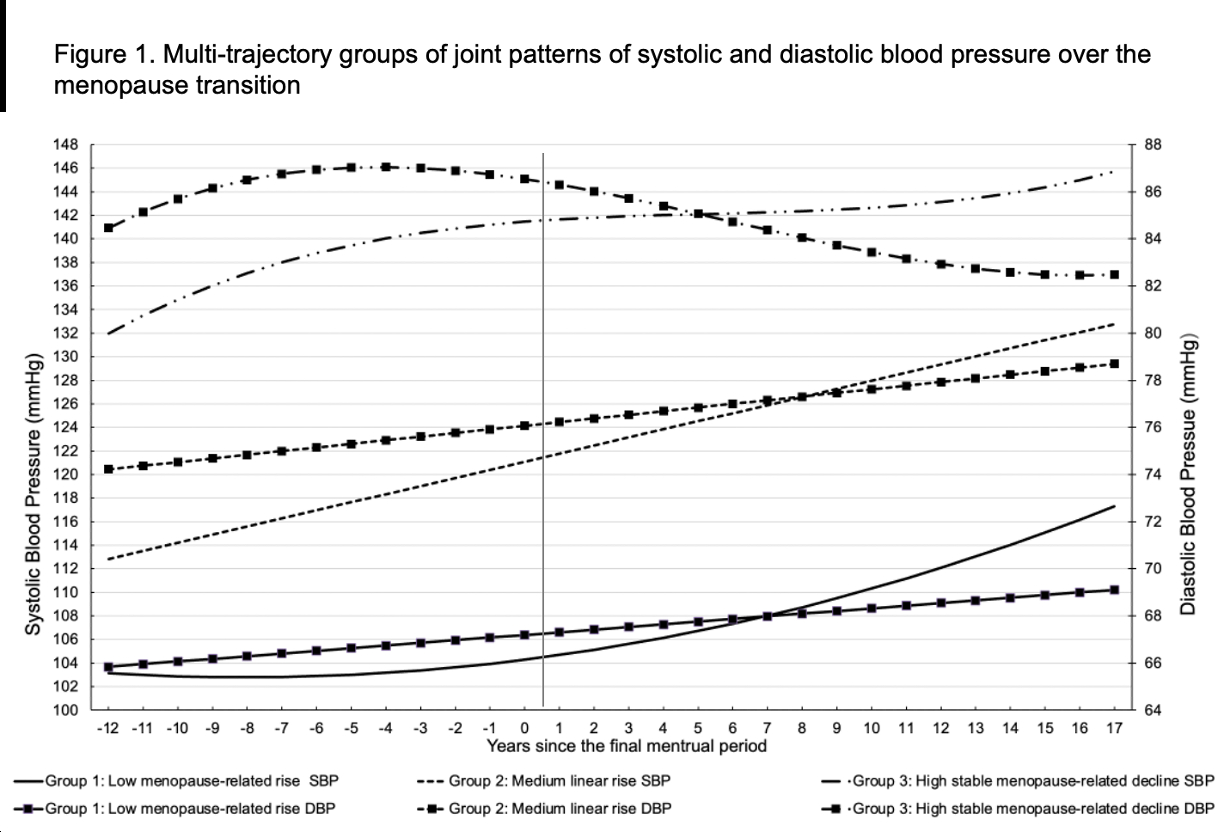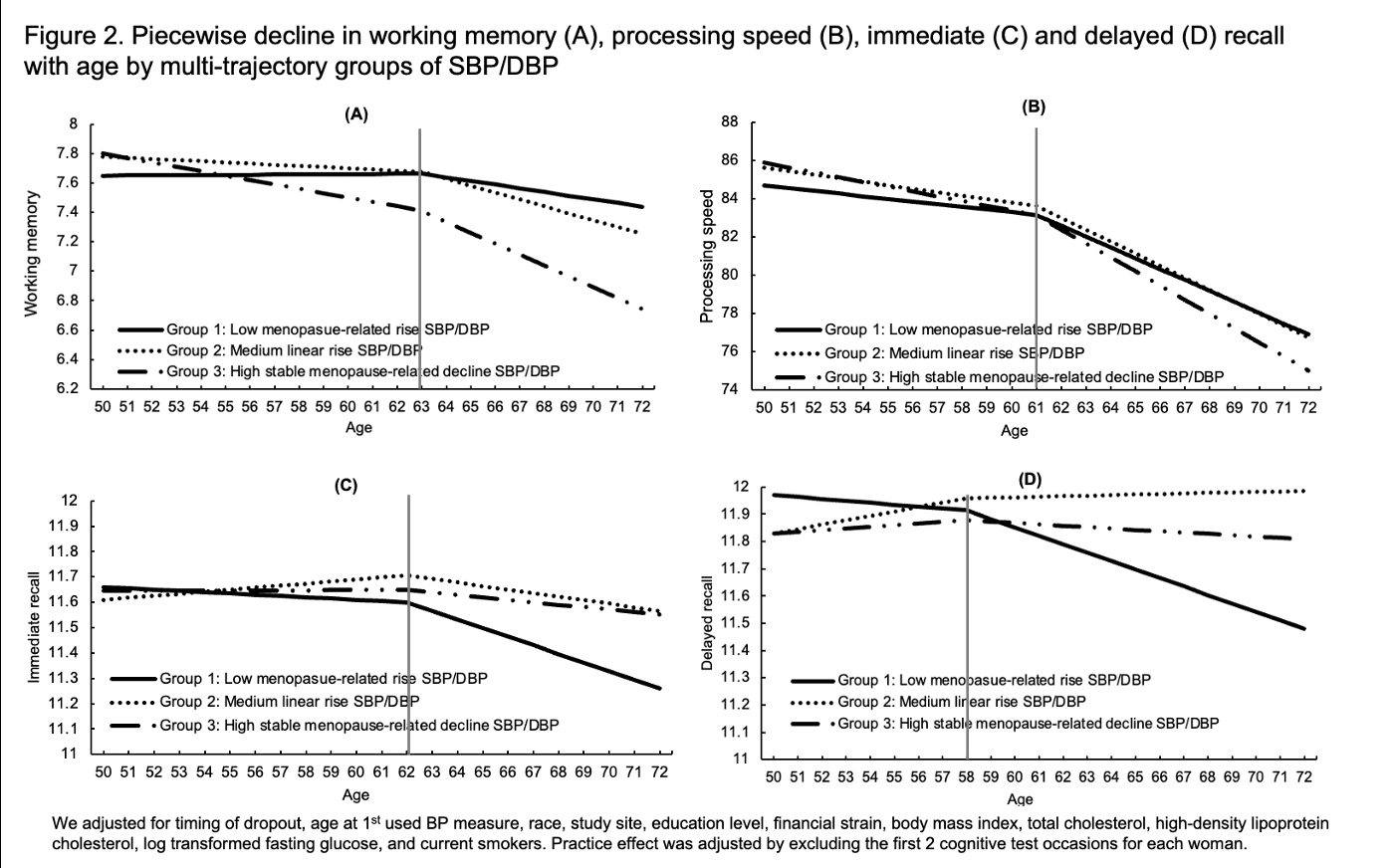Final ID: P2096
Women’s Midlife Systolic and Diastolic Blood Pressure Multi-trajectories and Future Cognitive Decline: The Study of Women’s Health Across the Nation (SWAN)
Abstract Body: Objective: Hypertension is more predictive of dementia risk at midlife than later in life. We previously showed that distinct subsets of midlife women experience menopause-specific changes in systolic (SBP) and diastolic BP (DBP), respectively. Given women’s higher prevalence of AD, clustering women based on midlife changes in SBP and DBP simultaneously may enhance our understanding of the link between midlife blood pressure and dementia. Therefore, we aimed to identify latent clusters of women sharing levels and patterns of SBP and DBP over the menopause transition (MT) and evaluate the association of the identified clusters with cognitive decline.
Methods: Group-based multi-trajectory model was used to group SWAN women based on distinct joint patterns of SBP and DBP over the MT; a linear trajectory suggests a dominant aging contribution while a non-linear would more likely be related to the MT. For those with cognitive measures, multivariable adjusted piecewise mixed-effect models were applied to assess associations of the identified SBP/DBP trajectory groups with longitudinal cognitive measures (working memory, processing speed, and episodic memory immediate and delayed recall).
Results: Three distinct BP groups were identified in 2700 women (aged 46±2.65 years at the 1st BP measure): Group 1: low menopause-related rise (low levels with menopause-related SBP rise and DBP linearly rise, 30.2%), Group 2: medium linear rise (medium levels with linear SBP and DBP rises, 45.2%), and Group 3: high stable menopause-related decline (high levels with persistently high SBP and DBP decline around menopause, 24.6%). (Figure 1) Of the 2700 women, 2356 had their 1st included cognitive measure assessed at 54±3.84 years. Nonlinear declines in working memory, processing speed, and immediate and delayed recall were found with inflection points at ages 63, 61, 62, and 58, respectively. Compared to group 1, group 3 showed greater working memory decline before the age of 63 years, while group 2 showed less immediate and delay recall declines before 62 and 58 years old, respectively. No significant differences across groups were observed in processing speed declines with age. (Figure 2)
Conclusion: Blood pressure trajectory patterns characterized by SBP rises or DBP declines close to menopause were linked to greater declines in episodic and working memory later in life, respectively.
Methods: Group-based multi-trajectory model was used to group SWAN women based on distinct joint patterns of SBP and DBP over the MT; a linear trajectory suggests a dominant aging contribution while a non-linear would more likely be related to the MT. For those with cognitive measures, multivariable adjusted piecewise mixed-effect models were applied to assess associations of the identified SBP/DBP trajectory groups with longitudinal cognitive measures (working memory, processing speed, and episodic memory immediate and delayed recall).
Results: Three distinct BP groups were identified in 2700 women (aged 46±2.65 years at the 1st BP measure): Group 1: low menopause-related rise (low levels with menopause-related SBP rise and DBP linearly rise, 30.2%), Group 2: medium linear rise (medium levels with linear SBP and DBP rises, 45.2%), and Group 3: high stable menopause-related decline (high levels with persistently high SBP and DBP decline around menopause, 24.6%). (Figure 1) Of the 2700 women, 2356 had their 1st included cognitive measure assessed at 54±3.84 years. Nonlinear declines in working memory, processing speed, and immediate and delayed recall were found with inflection points at ages 63, 61, 62, and 58, respectively. Compared to group 1, group 3 showed greater working memory decline before the age of 63 years, while group 2 showed less immediate and delay recall declines before 62 and 58 years old, respectively. No significant differences across groups were observed in processing speed declines with age. (Figure 2)
Conclusion: Blood pressure trajectory patterns characterized by SBP rises or DBP declines close to menopause were linked to greater declines in episodic and working memory later in life, respectively.
More abstracts on this topic:
Acute Bilateral Breast Swelling as a Rare Manifestation of Heart Failure Exacerbation: A Case Report
Mohyeldin Moiud, Anto Anandu, Hossain Muhammad
A Comparison of Synchronized Versus Unsynchronized Mechanical Chest Compressions in a Swine ModelMarill Keith, Menegazzi James, Gumucio Jorge, Salcido David


